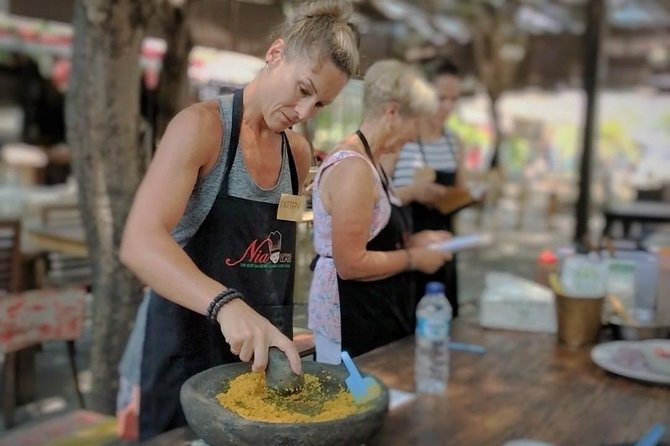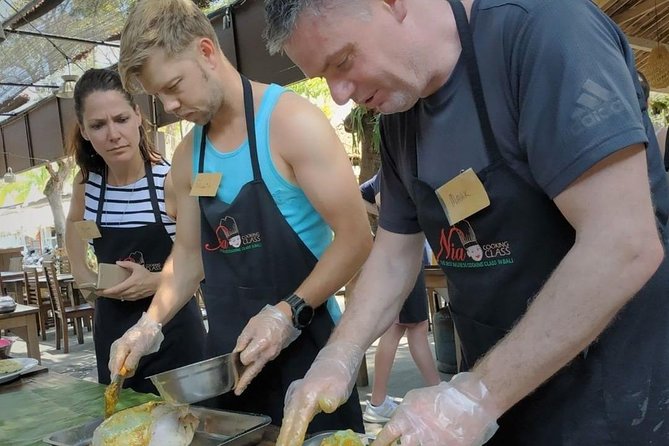The Nia Balinese Cooking Class offers visitors a unique culinary experience in the heart of Bali. Led by a skilled local chef, you will learn the art of traditional Balinese cuisine.
From creating aromatic spice pastes to perfecting the art of cooking rice, this class promises to be both educational and delicious.
With a maximum of 15 participants, guests can expect an intimate and personalized experience.
Whether you’re a seasoned chef or just starting out, this class will leave you with a newfound appreciation for Balinese cuisine.
Key Takeaways

- Balinese cuisine is influenced by Indian, Chinese, and Indonesian cultures and is known for its bold and vibrant flavors achieved through traditional ingredients.
- Nia’s signature dishes, such as Sate Lilit and Ayam Betutu, showcase her culinary expertise and passion for Balinese cuisine.
- Balinese cooking emphasizes the use of locally sourced and seasonal ingredients, as well as the balance of sweet, sour, salty, and spicy flavors.
- The cooking class not only equips students with the knowledge and skills to recreate authentic Balinese dishes at home but also fosters an appreciation for Balinese culture and promotes the preservation of Balinese culinary traditions.
The History of Balinese Cuisine

The history of Balinese cuisine dates back centuries, with its roots deeply intertwined with the culture and traditions of the island.
Balinese cuisine is characterized by its vibrant flavors, fresh ingredients, and rich culinary heritage. Influenced by various cultures such as Indian, Chinese, and Indonesian, Balinese cuisine has developed its unique identity over time.
The use of aromatic spices, such as turmeric, ginger, and lemongrass, is prominent in many Balinese dishes, adding depth and complexity to the flavors.
Rice, as the staple food, is an integral part of Balinese cuisine and is often served alongside a variety of side dishes, such as satay, lawar (a traditional salad), and babi guling (spit-roasted suckling pig).
Balinese cuisine not only nourishes the body but also reflects the deep connection between food, tradition, and spirituality on the island.
Traditional Balinese Ingredients and Spices

Nia’s Balinese Cooking Class uses a wide range of flavorful ingredients and spices, offering participants an authentic and immersive culinary experience. Balinese cuisine is known for its bold and vibrant flavors, which are achieved through the use of various traditional ingredients and spices.
One of the key ingredients in Balinese cooking is bumbu, a spice paste made from a combination of shallots, garlic, chili peppers, turmeric, ginger, and other aromatic herbs and spices. This paste is used as a base for many Balinese dishes, adding depth and complexity to the flavors.
Other common ingredients include lemongrass, galangal, kaffir lime leaves, and coconut milk. These ingredients, combined with the skillful techniques taught in Nia’s class, allow participants to create dishes that are bursting with flavor and reflect the rich culinary heritage of Bali.
Nia’s Signature Dishes
Nia excels at whipping up her signature dishes, tantalizing the taste buds of all who’ve the pleasure of dining at her Balinese cooking class. Her culinary creations are a blend of traditional Balinese flavors and modern techniques, resulting in dishes that are both familiar and innovative.
Here are three of Nia’s most popular signature dishes:
-
Sate Lilit: These succulent skewers are made with minced meat, usually chicken or fish, mixed with a fragrant blend of spices, coconut milk, and grated coconut. Grilled to perfection, they offer a burst of flavors with every bite.
-
Ayam Betutu: This traditional Balinese dish features a whole chicken marinated in a rich blend of spices, including turmeric, ginger, and shallots. Slow-cooked in banana leaves, the chicken becomes incredibly tender and infused with the aromatic flavors of the marinade.
-
Babi Guling: A Balinese favorite, Babi Guling is a whole roasted suckling pig that’s seasoned with a combination of spices, such as coriander, turmeric, and lemongrass. The result is a crispy skin and tender meat that’s bursting with savory flavors.
Nia’s signature dishes are a testament to her culinary expertise and passion for showcasing the flavors of Balinese cuisine.
Step-by-Step Balinese Cooking Techniques
.jpg)
Nia demonstrates step-by-step Balinese cooking techniques, showing her students how to create authentic dishes using traditional methods and fresh ingredients.
She begins by explaining the importance of using locally sourced and seasonal ingredients in Balinese cuisine.
Nia then guides her students through the process of preparing the ingredients, such as chopping vegetables and grinding spices using a mortar and pestle.
She emphasizes the balance of flavors in Balinese cooking, combining sweet, sour, salty, and spicy elements to create harmonious dishes.
Nia teaches her students how to cook rice, the staple food of Bali, using the traditional method of steaming.
She also demonstrates the art of making sambal, a spicy chili sauce that accompanies many Balinese dishes.
Through her engaging and informative teaching style, Nia ensures that her students leave with the knowledge and skills to recreate authentic Balinese dishes at home.
Tips and Tricks for Perfecting Balinese Flavors
.jpg)
She shares her personal tips and tricks for perfecting Balinese flavors, ensuring that her students can elevate their dishes to an authentic level.
Here are three key tips to help you master the art of Balinese cooking:
-
Use traditional Balinese spices: Balinese cuisine is known for its rich and aromatic flavors, which come from a variety of spices. Nia recommends using a combination of turmeric, ginger, garlic, lemongrass, and galangal to add depth and complexity to your dishes.
-
Balinese sambal is a must: Sambal is a spicy chili paste that’s a staple in Balinese cuisine. Nia suggests making your own sambal by grinding together shallots, chili peppers, shrimp paste, and lime juice. This fiery condiment adds a kick of flavor to any Balinese dish.
-
Embrace the use of fresh ingredients: Balinese cuisine relies heavily on fresh, locally sourced ingredients. Nia emphasizes the importance of using fresh herbs, vegetables, and spices to enhance the flavors of your dishes. Don’t be afraid to experiment with different ingredients to create your own unique Balinese flavors.
Exploring the Unique Balinese Cooking Equipment
.jpg)
The students in the Balinese cooking class are fascinated by the variety of cooking equipment used in traditional Balinese cuisine. The instructor explains that the use of banana leaves and clay pots are two key elements in Balinese cooking.
The use of banana leaves isn’t only practical, but also adds a unique flavor to the dishes. The leaves are used to wrap ingredients before steaming or grilling, creating a moist and flavorful result. This method is commonly used in Balinese cuisine and is a traditional way of cooking.
On the other hand, the clay pots are known for their ability to retain heat and distribute it evenly. This is perfect for slow and gentle cooking, which is often required for traditional Balinese dishes. The clay pots allow the flavors to develop over a long period of time, resulting in rich and delicious dishes.
The students eagerly take notes and ask questions, eager to try these cooking techniques back home. They are excited about the prospect of using banana leaves and clay pots to recreate the authentic flavors of Balinese cuisine in their own kitchens.
Nia’s Secret Family Recipes Revealed
Interestingly, all of Nia’s secret family recipes were revealed during the cooking class, and the students were amazed by the delicious flavors and unique techniques. It was a truly unforgettable experience for everyone involved.
Here are three highlights from the class:
-
Authentic Ingredients: Nia shared her knowledge of traditional Balinese ingredients, such as lemongrass, galangal, and palm sugar. The students were able to see and taste these ingredients firsthand, gaining a deeper understanding of the flavors that make Balinese cuisine so special.
-
Masterful Techniques: Nia demonstrated her expert culinary skills, teaching the students how to properly chop, pound, and mix ingredients. They learned the art of creating flavorful spice pastes, and the secret behind perfectly cooked rice and tender grilled meats.
-
Flavorful Dishes: From aromatic curries to sizzling stir-fries, the students had the opportunity to prepare and enjoy a variety of mouthwatering Balinese dishes. Each recipe showcased the harmonious blend of spices and fresh ingredients that are the hallmark of Nia’s family recipes.
The cooking class was a delightful journey into the heart of Balinese cuisine, leaving the students inspired and eager to recreate these amazing flavors in their own kitchens.
Frequently Asked Questions
Is the Activity Suitable for Individuals With Dietary Restrictions or Allergies?
Individuals with dietary restrictions or allergies should be cautious when participating in the activity. It is not recommended for travelers with vitamin allergies. It is advised to inquire about specific dietary accommodations before booking.
How Long Is the Cooking Class?
The cooking class lasts approximately 3 hours. Participants will learn traditional Balinese cooking techniques and create delicious dishes under the guidance of a skilled instructor. It’s a fun and educational experience for all.
Is Transportation Provided to and From the Meeting Point?
Transportation to and from the meeting point is provided for the Nia Balinese Cooking Class. Participants can expect a convenient and hassle-free experience with transportation arrangements taken care of by the organizers.
Can Children Participate in the Cooking Class?
Children can participate in the cooking class. The activity is stroller accessible and infant seats are available. It is a fantastic experience for everyone, with a great teacher and delicious food. Highly recommended.
Is There a Minimum Age Requirement for Participants?
There is no minimum age requirement for participants in the Nia Balinese Cooking Class. All ages are welcome to join and learn the art of Balinese cooking from a knowledgeable instructor.
The Sum Up
To sum it up, the Nia Balinese Cooking Class offers a one-of-a-kind culinary experience that allows visitors to delve into the rich history and flavors of traditional Balinese cuisine. With a skilled local chef as your guide, you’ll learn the art of creating authentic Balinese dishes, from aromatic spice pastes to perfectly cooked rice. The class is accessible to all visitors and provides an intimate and personalized experience. Whether you’re a seasoned chef or a beginner, this cooking class is sure to leave you with a newfound appreciation for Balinese cuisine.
For those interested in exploring other culinary experiences in Asia, there are several options to consider. One highly recommended class is the Kyoto Bento Box Cooking Class, which not only teaches you how to create delicious Japanese bento boxes but also provides take-home recipes for you to recreate the dishes at home. Another option is the Hanoi Coffee Workshop, where you can learn about the different types of coffee in Vietnam, including the famous egg coffee and coconut coffee.
If you’re looking for a more immersive experience, the Traditional Japanese Cooking Class in Tokyo is a fantastic choice. Hosted at Mayuko’s home, you’ll learn traditional Japanese cooking techniques and get a glimpse into the local culture. Another option for sushi lovers is the Sushi Making Experience in Kyoto, where you’ll learn the art of making beautiful and delicious sushi rolls.
Each of these cooking classes offers a unique perspective on Asian cuisine and provides an opportunity to learn from skilled local chefs. Whether you choose to explore the flavors of Cambodia, Vietnam, Japan, or Thailand, you’re sure to have an unforgettable culinary experience. So why not expand your culinary horizons and embark on a cooking adventure? Book your next cooking class today and discover the diverse and delicious world of Asian cuisine.
Kyoto Bento Box Cooking Class offers a hands-on experience in creating delicious Japanese bento boxes, while the Hanoi Coffee Workshop introduces visitors to the unique coffee culture in Vietnam.
For those interested in traditional Japanese cuisine, the Traditional Japanese Cooking Class in Tokyo provides an immersive experience in a local home. Lastly, sushi enthusiasts can join the Sushi Making Experience in Kyoto to learn the art of making delicious sushi rolls.






